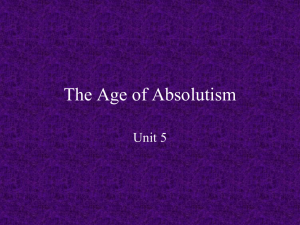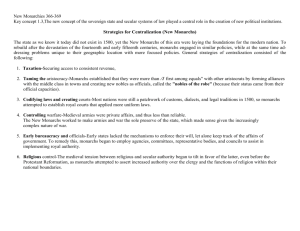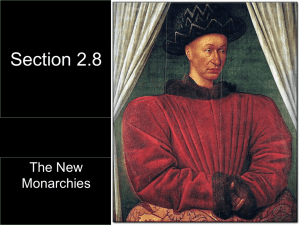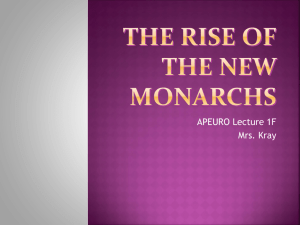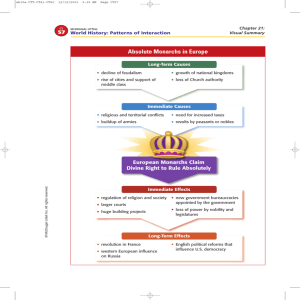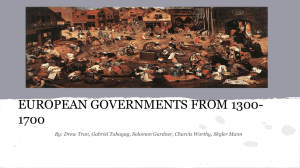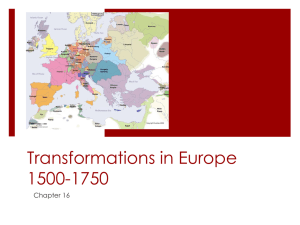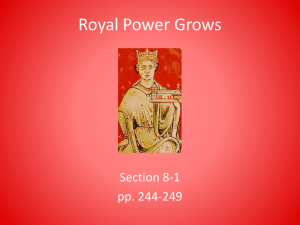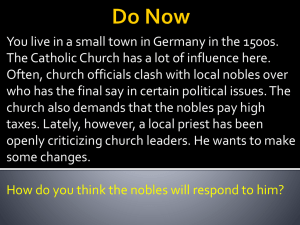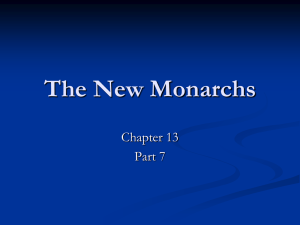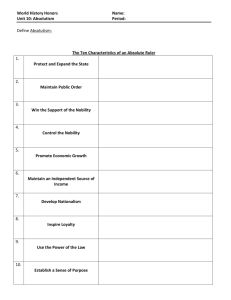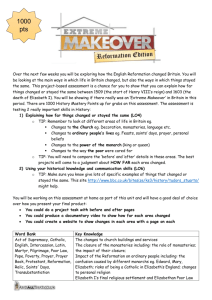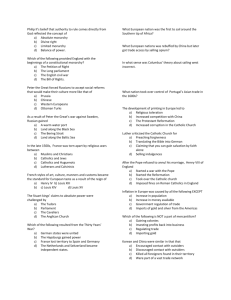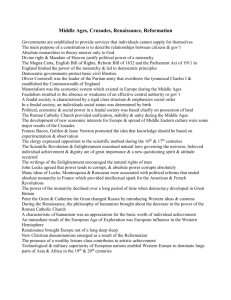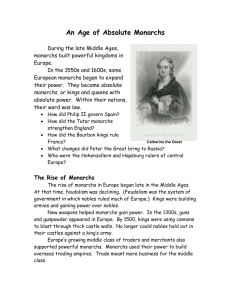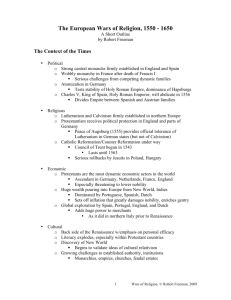Cram Packet II
advertisement
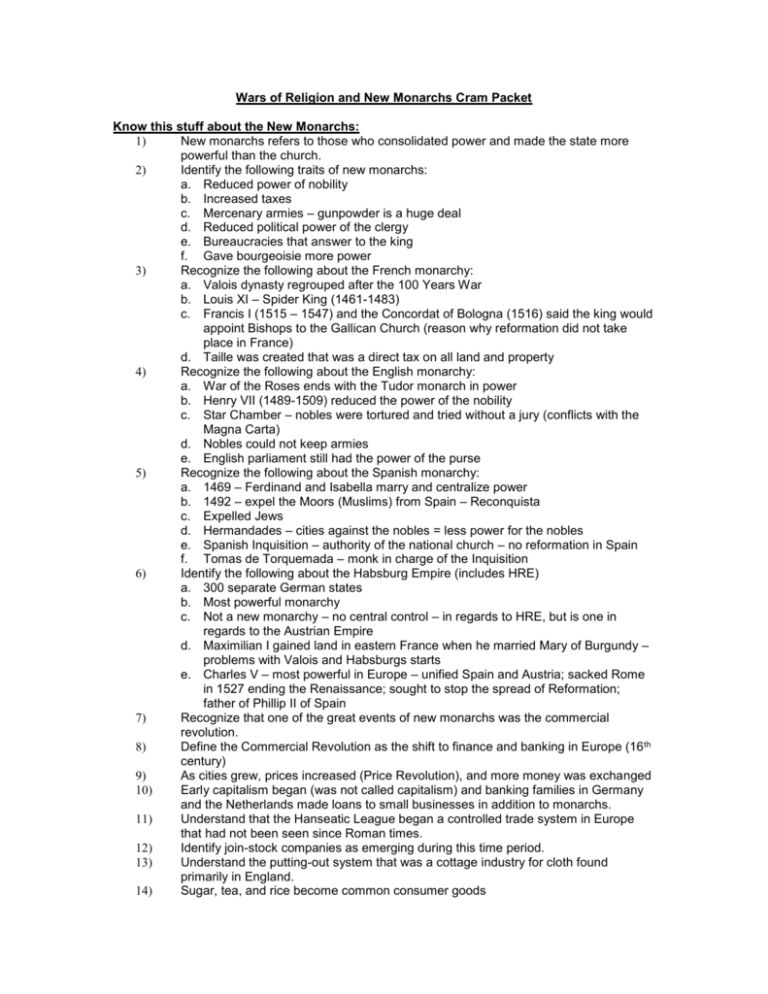
Wars of Religion and New Monarchs Cram Packet Know this stuff about the New Monarchs: 1) New monarchs refers to those who consolidated power and made the state more powerful than the church. 2) Identify the following traits of new monarchs: a. Reduced power of nobility b. Increased taxes c. Mercenary armies – gunpowder is a huge deal d. Reduced political power of the clergy e. Bureaucracies that answer to the king f. Gave bourgeoisie more power 3) Recognize the following about the French monarchy: a. Valois dynasty regrouped after the 100 Years War b. Louis XI – Spider King (1461-1483) c. Francis I (1515 – 1547) and the Concordat of Bologna (1516) said the king would appoint Bishops to the Gallican Church (reason why reformation did not take place in France) d. Taille was created that was a direct tax on all land and property 4) Recognize the following about the English monarchy: a. War of the Roses ends with the Tudor monarch in power b. Henry VII (1489-1509) reduced the power of the nobility c. Star Chamber – nobles were tortured and tried without a jury (conflicts with the Magna Carta) d. Nobles could not keep armies e. English parliament still had the power of the purse 5) Recognize the following about the Spanish monarchy: a. 1469 – Ferdinand and Isabella marry and centralize power b. 1492 – expel the Moors (Muslims) from Spain – Reconquista c. Expelled Jews d. Hermandades – cities against the nobles = less power for the nobles e. Spanish Inquisition – authority of the national church – no reformation in Spain f. Tomas de Torquemada – monk in charge of the Inquisition 6) Identify the following about the Habsburg Empire (includes HRE) a. 300 separate German states b. Most powerful monarchy c. Not a new monarchy – no central control – in regards to HRE, but is one in regards to the Austrian Empire d. Maximilian I gained land in eastern France when he married Mary of Burgundy – problems with Valois and Habsburgs starts e. Charles V – most powerful in Europe – unified Spain and Austria; sacked Rome in 1527 ending the Renaissance; sought to stop the spread of Reformation; father of Phillip II of Spain 7) Recognize that one of the great events of new monarchs was the commercial revolution. 8) Define the Commercial Revolution as the shift to finance and banking in Europe (16 th century) 9) As cities grew, prices increased (Price Revolution), and more money was exchanged 10) Early capitalism began (was not called capitalism) and banking families in Germany and the Netherlands made loans to small businesses in addition to monarchs. 11) Understand that the Hanseatic League began a controlled trade system in Europe that had not been seen since Roman times. 12) Identify join-stock companies as emerging during this time period. 13) Understand the putting-out system that was a cottage industry for cloth found primarily in England. 14) Sugar, tea, and rice become common consumer goods 15) 16) 17) 18) 19) 20) 21) 22) 23) 24) 25) Identify nations efforts at mercantilism and understand that this led to increased exploration and colonization. These new products needed markets and resources – more trade routes and colonization. Understand that Europeans wanted to increase trade that began in the Middle Ages and sought trade routes. Francis Xavier was a missionary in the East Indies. As trade increased, knowledge about other places increased and education changed to embrace lost texts and knowledge from the Arabs and Asians. During this time, maps were made (cartography) and astronomy became significant. Commercial revolution resulted in capitalist investments in overseas missions and a spread of religion. Identify major explorers and others from the era: a. Prince Henry b. Dias c. Da Gama d. Cabral e. Vespucci f. Columbus g. De las Casas h. Magellan Recognize that the Treaty of Tordesillas divided land between Spain and Portugal. Identify the conquistadores: a. Cortes b. Pizarro Define the encomienda system as the social and political structure set up in the new world where Europeans had power and natives did not. Know this stuff about the Wars of Religion: 1) Religion was the cause of most wars in the 16th and early 17th centuries. 2) During the Reformation the Habsburg-Valois Wars were centered in the German states. It ended with the Treaty of Cateau-Cambresis. 3) Philip II led a Catholic Crusade throughout Europe. He built the Escorial as a monastery and mausoleum and defeated the Turks off the coast of Greece. 4) The Dutch Revolt included the United Provinces of the Netherlands (northern part) and was led by William of Orange I; Calvinism was on the rise. The southern part (Belgium today) remained firmly under Spanish control – Spanish Netherlands; protestants such as Elizabeth I sent money to the Dutch 5) In England, Mary I, the very Catholic daughter of Catherine of Aragon and the wife of Phillip II of Spain, begins to demand that England reconvert to Catholicism. She is called “Bloody Mary” for her efforts. 6) Elizabeth I of England was a POLITIQUE. This meant that she was more interested in politics than religion. She was protestant, but she did not condemn Catholics. Many plots were in place during her reign, primarily led by her Catholic cousin, Mary Queen of Scots. Elizabeth kills Mary, but when Elizabeth dies she names Mary’s Presbyterian son, James VI of Scotland, as her heir. England and Scotland have had the same monarch ever since. 7) Phillip II’s Armanda was defeated by Elizabeth; however, Phillip had other concerns in the Spanish Netherlands where the Protestants rebelled. 8) Identify Huguenots as French Calvinists. Identify Catherine de Medici’s order of St. Bartholomew’s Day Massacre as the beginning of religious conflict in France. With the death of the last of Catherine’s sons, the War of the Three Henrys begins with Henry of Navarre agreeing to convert to Catholicism (Paris is Worth a Mass). 9) Recognize the Thirty Years War as the first war that involved all major European countries. There were several phases of the Thirty Years War. These were the 26) 27) 28) Bohemian Phases (Defenestration of Prague), the Danish Phase, the Swedish Phase, and the French-Swedish (sometimes called International) Phase. Protestants normally supported Protestants and Catholics normally supported Catholics. The exception was Catholic France who under the leadership of Cardinal Richelieu supported the Protestant princes in Germany. France wanted to end the power of the Habsburgs and so they supported the enemy of the Habsburgs (the enemy of my enemy is my friend). France was really ruled by Cardnal Richelieu. Treaty of Westphalia ended the Catholic Reformation in Germany. It renewed the Peace of Augsburg (but added Calvinism as a choice), gave Dutch and Swiss independence; gave German states more independence from the Emperor; Prussia becomes a major power. The results of the 30 years War included Germany’s loss of 1/3 of life in some areas and a destruction of their land and economy (only the world wars would be more destructive on any one country); end to the wars of religion; begins the rise of France and the balance of power in Europe
